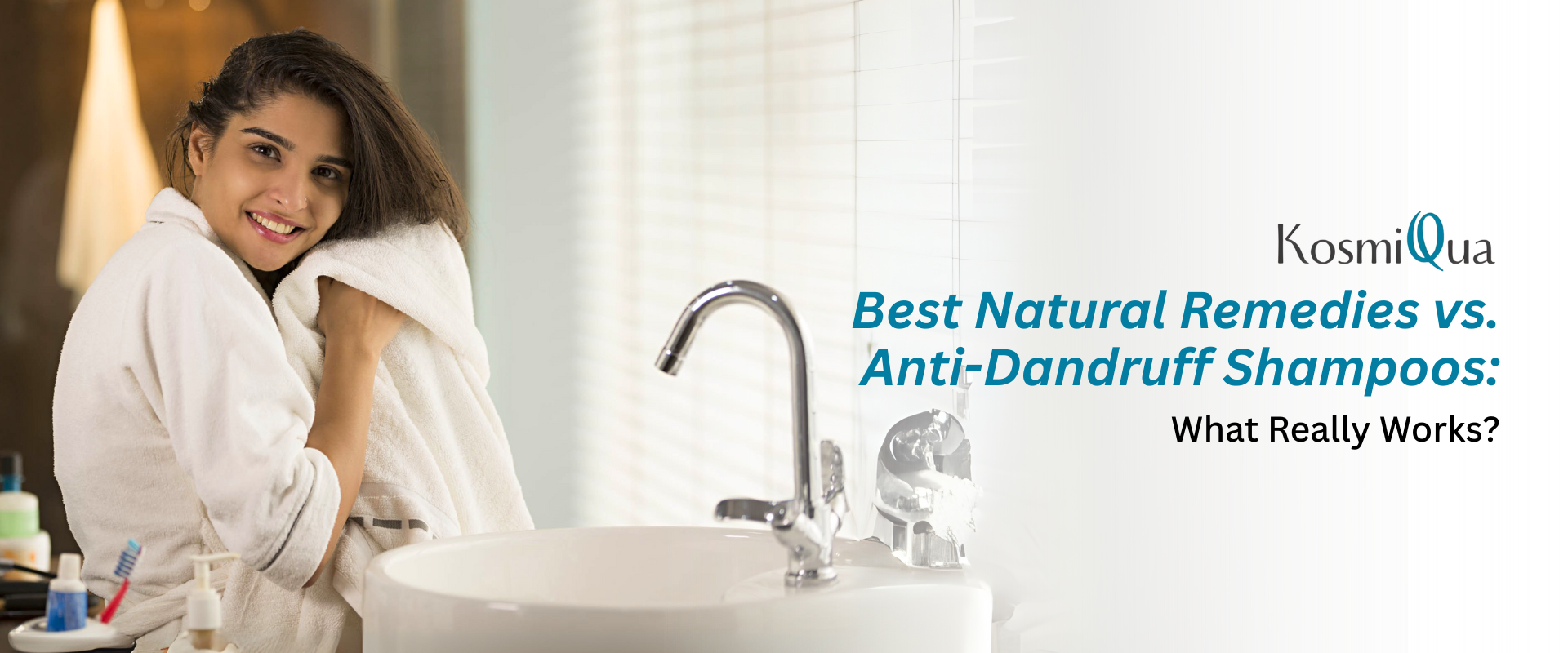We’ve all encountered that moment of dread, when you see some involving white flakes on your black shoulders. Dandruff can be more than a cosmetic issue and a source of frustration for millions. This dilemma often leads people down one of two paths: the enticing, holistic world of natural remedies, or the clinically-proven aisle of anti-dandruff shampoos.
As a consumer, how do you decide? But this choice isn’t just a concern for individuals. If you’re a brand formulating these products, sourcing the most effective, high-quality ingredients is the entire foundation of your solution. The quest for reliable, high-performing ingredients is the critical next step.
One question though, it’s not as easy as “natural” versus “chemical.” It is a question of science, efficacy and understanding the “why” behind dandruff. At Kosmiqua, we look at the issue through two lenses – the end-user looking for relief and the brands looking for a solution.Let’s peel back the layers and see what the scientific research reveals, to help you make an informed decision.
What exactly is Dandruff?
You can’t defeat an enemy you don’t understand. So, let’s get to the root cause. Dandruff is caused by an overproduction of a naturally occurring, yeast-like fungus called Malassezia globosa. This microbe feeds on sebum—our natural oils—on the scalp, breaking it down into oleic acid. About half the population is sensitive to oleic acid. This sensitivity triggers inflammation, accelerating skin cell turnover, causing them to group together as dead, visible skin cells, better known as dandruff.
Understanding this cause is the first step to interpreting the effectiveness of any treatment (even if that treatment was brewed in a kitchen cookbook, or is made in a laboratory with exact science).
What are the Popular Natural Remedies for Dandruff?
There is no denying the temptation of natural remedies. They seem kinder, can often be easier to find, and feed into the increasing demand for clean and transparent ingredients. But does the science support the hype?
- Tea Tree Oil :
It is famous for its purported antimicrobial and anti-inflammatory effects. The natural terpinen-4-ol component targets Malassezia. It can irritate some scalps and *must* be diluted. This is precisely why the grade and purity of the oil are critical for both safety and efficacy—a key factor in our selection process at Kosmiqua.
- Apple Cider Vinegar (ACV):
Its acidity is thought to restore the pH of the scalp to make it less favorable for fungus, and slough off dead skin cells. While the idea is logical this line of reasoning does not have much clinical evidence to back up its safety and efficacy. It has acidity, which gives it a temporary exfoliation effect but does not inhibit Malassezia fungus effectively. It also may be excessively drying and damage the hair in the long run.
- Coconut Oil:
Good for alleviating dryness, itching, and redness of the scalp. Coconut oil is an excellent moisturizer. It may be useful for scalp itching caused by dry skin. However, when treating dandruff caused by fungus like Malassezia, it can be hit or miss. Because *Malassezia* feeds on oils, recommending pure coconut oil could make some individuals’ condition worse.
The Verdict on Naturals: Although some natural ingredients appear to be useful (like high quality tea tree oil), they tend not to work regularly. The variables of dosage, stability, and sensitivity of the scalp result in a gamble with DIY natural solutions.
How Anti-Dandruff Shampoos Help?
Medicated anti-dandruff shampoos take an intentional, evidence-based approach to treatment and are formulated with specified active ingredients that directly address the root cause of your dandruff.
1. Zinc Pyrithione:
This powerful ingredient has both antifungal and antibacterial activities, and reduces the population of Malassezia on the scalp. It is one of the most used and studied ingredients. Very tolerable, effective for mild to moderate dandruff, and has a longstanding safety profile. This is an ingredient that is found in many trusted brands sourced through our products.
2. Ketoconazole:
A powerful broad-spectrum antifungal that specifically targets and destroys fungal cells. It is often used as a first-line treatment for more resistant and severe dandruff and seborrheic dermatitis. Its use is supported by clinical data. This is precisely why, for brands, reliably sourcing a high-purity, potent ingredient like ketoconazole is non-negotiable for product efficacy—a core focus of our work at Kosmiqua.
3. Selenium Sulfide:
It reduces the rate of skin cell death and turnover and has antifungal properties against Malassezia. Extremely potent but can be aggravating, even resulting in some discoloration on light hair color. This highlights the importance of balanced formulations that maximize benefits while minimizing potential side effects.
4. Salicylic Acid:
This is a keratolytic agent. It does not combat the fungus directly, it acts by breaking down and promoting the shedding of the outer layer of dead skin (in a sense, it exfoliates the scalp and scraps off the flakes). Good at managing the symptom of flaking, and often paired with antifungal agents for a double-whammy treatment.
What Works?
So, what truly wins the battle against dandruff? The verdict points squarely to evidence-based action.
While natural solutions may provide a gentle, complementary choice for some, clinically proven anti-dandruff shampoos offer a predictable and efficacious solution to the fundamental biological issues underlying dandruff.
The real winner is anyone, whether a consumer or a business, who makes choices based on science and proven quality. This means choosing products formulated with proven, responsibly sourced active ingredients, that may originate from nature or be synthesized.
At Kosmiqua, we support that informed action. By connecting a worldwide network of suppliers and buyers, we help ensure the products that reach the shelf and consequently, your scalp are provably effective, not just potentially so.


